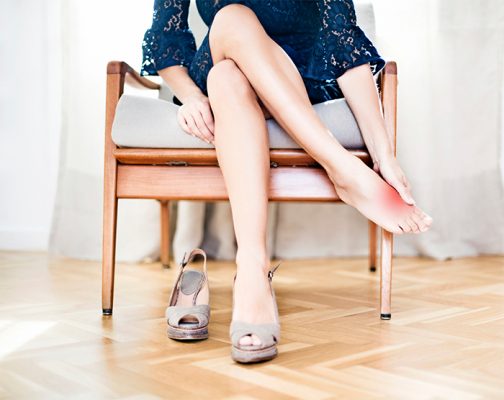Painful feet can be caused by different things. Having the knowledge on what may be the cause and how to relieve it is very useful. Check out the article we found at Top 10 Home Remedies.
Wearing Very High-Heeled Shoes
One of the main causes of foot pain is wearing high-heeled shoes, as they put a great deal of pressure on the toes.
Any heel that is over 2.5 inches can put a lot of pressure on the ball of the foot and constrict your foot’s natural shape, leading to pain.
Apart from pain, high heels can contribute to a host of issues, such as stress fractures, bursitis, sprained ankles and neuroma.
To fix this problem:
- Choose shoes with thicker heels for better balance and reduced pressure.
- Alternate between shorter and higher heels to give your feet a break from foot pain.
- It is better to opt for open-toe high heels, as this type of shoe limits the pressure and discomfort.
- If you have blisters, opt for padding and cushions for blisters, which you can easily find in the market.
- After a long hectic day, soak your feet in warm water with a little salt for 15 minutes.
- Before going to bed, give the soles of your feet a nice massage. This helps improve circulation and reduce pain.
Wearing Poorly Fitting Shoes
Wearing poorly fitting shoes can also cause foot pain. When shoes are too tight or too narrow, your toes have to bear a lot of pressure. The toes start rubbing against your shoes, causing irritation and pain.
As you are on your feet most of the time, walking around in shoes that don’t fit well is also harmful for the muscles, joints and ligaments in your feet, legs, hips and back.
It is important to check your shoe size from time to time. Feet continue to change with age. Get your feet measured at least once a year when you are out shopping for shoes.
To fix this problem:
- Invest in a good, solid pair of shoes with a textured sole and ankle support.
- Buy new shoes regularly, about every 6 to 8 months.
- Always buy shoes in the late afternoon. Your feet tend to swell a little after you’ve been walking around for most of the day, and you’ll want to buy shoes that feel comfortable from morning to night.
- When shopping for a pair of shoes, make sure to try on both shoes and walk a few steps.
- Along with shoes, look for socks that come with special padding in specific areas, such as the toe and heel areas.
- If needed, consult a podiatrist to help you choose the right type of footwear.
Pregnancy
Foot pain is a common complaint during pregnancy, just like morning sickness, back strain, fatigue and tiredness.
Your legs and feet tend to get more tired due to the increasing body weight. As the weight gain continues, a woman’s center of gravity is completely altered. This puts added pressure on the knees and feet.
Foot pain often gets worse as the day progresses, especially during the second and third trimesters.
The good thing about foot pain and swelling during pregnancy is that they eventually go away after delivery.
In the meantime, to fix this problem:
- Keep your feet elevated as often as you can.
- Drink a lot of fluids, as dehydration can worsen swelling as well as pain.
- Improve the circulation in your ankles with rotation exercises.
- With your feet elevated, place a cold compress on your feet for 15 to 20 minutes, 2 or 3 times a day.
Ingrown Toenails
Ingrown toenails cause a throbbing, painful sensation, and usually affect the big toes.
An ingrown toenail occurs when the side edge of your nail curls down and digs into the toe’s skin, causing pain that makes you aware of a toe that you don’t normally even think about.
Wearing shoes that are too tight or too narrow can exacerbate an ingrown toenail.
To fix the problem:
- Enjoy a warm water foot soak a few times a day to reduce swelling, pain and tenderness. To increase the effectiveness, add a little Epsom salt or apple cider vinegar to the water.
- After soaking, you can use cotton or floss to gently lift the nail edge so that it doesn’t grow further into your skin.
- You can trim the nail yourself if there’s no infection.
- In case of an infection, always see your doctor or a podiatrist.
- To help prevent this problem, always cut your toenails straight across and don’t file the corners down.
Standing for Long Periods of Time
Standing is a natural human posture, but working in a standing position on a regular basis for long hours can cause sore feet, swelling in the legs as well as pain.
It even increases the risk of various foot and leg problems, due to the increased strain on the bones, joints, tendons, muscles and ligaments.
Also, standing for long periods of time accelerates tiredness and fatigue.
To fix the problem:
- If your job requires that you stand most of the time, wear comfortable shoes.
- While standing, periodically shift your weight from one leg to the other.
- Take sitting breaks of 10 minutes for each hour of standing.
- Avoid extreme bending, stretching and twisting.
- From time to time, stretch your legs.
- Roll a cold or frozen water bottle under your feet for about 20 minutes before going to bed.
- While sleeping, prop up your feet so they are higher than the rest of your body to reduce swelling and pain.
Next Article: This Simple Trick Can Get Rid Of Pain In Your Body
Read Full Article: 10 Reasons Why Your Feet Hurt All The Time and How to Fix It







Recent Comments